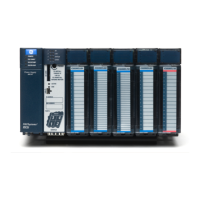Appendix A. Performance Data
GFK-2222AD April 2018 277
The following diagram shows the differences between the full sweep phases and the base sweep phases.
Base Sweep vs. Full Sweep Phases
<START OF SWEEP>
Sweep Housekeeping
NULL Input Scan
98
Program Logic Execution
NULL Output Scan
98
<END OF SWEEP>
<START OF SWEEP>
Sweep Housekeeping
Input Scan
98
EGD Consumption Scan
99
Program Logic Execution
Output Scan
98
EGD Production Scans
99
Poll for Missing I/O Modules
100
Controller Communications Window
Backplane Communications Window
<END OF SWEEP>
For the base sweep, if there is no configuration, the input and output scan phases of the sweep are NULL
(i.e., check for configuration and then end). The presence of a configuration with no I/O modules or
intelligent I/O modules (GBC) has the same effect. The logic execution time is not zero in the base sweep.
The time to execute the empty _MAIN program is included so that you only need to add the estimated
execution times of the functions actually programmed. The base sweep also assumes no missing I/O
modules. The lack of programmer attachment means that the Controller Communications Window is
never opened. The lack of intelligent option modules means that the Backplane Communications
Window is never opened.
If I/O is suspended, the input and output scans are skipped.
If no Ethernet Global Data (EGD) exchanges are configured, the consumption and production scans are skipped.
Polling for missing I/O modules only occurs if a Loss of ... fault has been logged for an I/O module.

